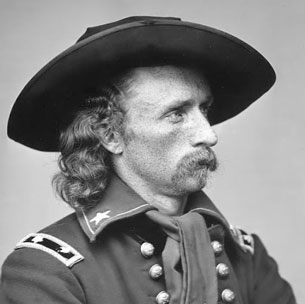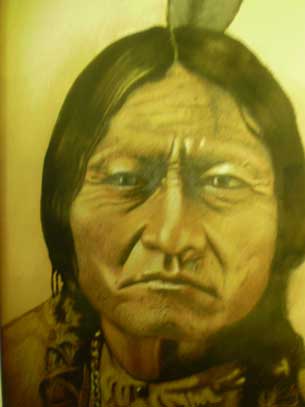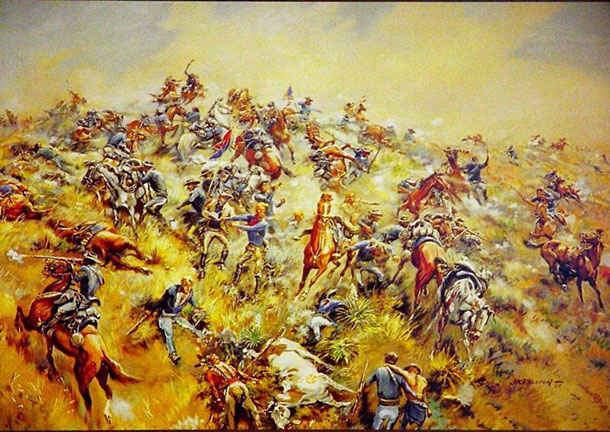
THUNDER BAY – This week a few colleagues returned to Thunder Bay, from a mid-summer’s quest through the American west, with illuminating new historical data they’d uncovered at Little Big Horn, Montana, on a field-trip to one of the most staggering military plunders in history. Prompting me to open journals I’d accumulated when our family paused to take in this very moving yet absolute myopic portfolio illustrating of a Government’s exercises in misapprehension and misdirection.
Truly such a gut wrenching misdirected plot that would inflame, incite, and embroil tensions between extremely different nations formerly attempting to co-exist.
Though both factions were ever so gingerly coping within their very own terms. Trying to maintain their existence, traditional ways, along one of the great frontiers of any other landscape inside the United States at the time. It was such an openly vast stretching region encompassing the big Buffalo plains beneath its Big Sky Country of the 19th Century.

A Few of My journals Read as Follows
At a local grocery in Rosebud, USA, the owner reminded his staff, as he carted boxes of folded brown paper bags to a counter, ‘’be sure to double bag all purchases today. Everything already seems to be in a state of soggy-side with the humidity to go with this.’’ His scale showed a mid-day temperature of 100 F. The same sweltering heat General George Armstrong Custer rode into at Little Bighorn before perishing in an outright, one-sided massacre known as Custer’s Last Stand. Our family drove into Montana to Custer’s indelible ending on that brilliant, sun blazing summer’s day as we were making a cross-continent trip to Seattle.
The scene is comparable to another War Memorial in Europe. Where hundreds upon hundreds of Allies killed there are commemorated with humble, white wooden crosses symbolizing the blood shed at Flanders. At Custer’s Last Stand there are 220 white markers. They dot the terrain where everyone in the 7th Cavalry Custer led, into the fray, were overwhelmingly defeated. What they encountered were Cheyenne, Arapaho, and Lakota tribes counting in the thousands making a summer’s rendez vous where they had set up their interim camps. This memorial has designated a place for every fallen soldier.
It was 1876. Everything leading up, in such a sinister way, to a worldwide, news-breaking story on that fatal 25th of June. Custer represented a kind of security blanket the US Government was sending to what was known as Dakota Territory. Attempting to persuasively moderate tensions between pioneers and American Indians whose ways in weekly living were obviously being disrupted. As events unfolded both the United States railway, and, the discovery of gold prompted Washington to impose sanctions. What they wanted was to push Native Americans away from the Black Hills. Putting them on what became Reservation land. Forever after called ‘’the Rez” by native inhabitants.
And what a bizarre, ‘’forked tongue.” turn in thinking where the U.S. Congress had formerly issued a proclamation indicating the Bad Hills would be Indian land forever. That’s where U.S. troops had tried to sequester many
Indian tribes as legions new wagonloads of settlers were being transported through Montana deeper into, and across, the American West and the Columbia River basin.
However, these tribes were extremely aware of what was unfolding. The double talk. Their personal let downs. Shattered visions. As well, their newly incorporated use of a word once originating from the Latin Senates In Rome of the 17th century: exacerbation. It defines feelings of bitterness. A word the Plains Indians were devoid of before Custer’s era.
And in doing Research during an Overseas Sabbatical in 1976 viewing Britain’s Hayward Gallery’s gigantic– deeply instructive and intensive—North American Retrospective entitled: Sacred Circles Bridging 2,000 Years of American Native Ways and Methods Of Survival my notebook collected a wealth of descriptions on Indian Life and Literature. My entries were like the following. ‘’An Aboriginal in the early formation of the United States live in a homeland that was nothing but space. The earth was a total environmental unit with them. While later an Indian’s possession in the training of horses expanded their domain everywhere. They roamed freely across wild natural theatres in their outreach. Riding as endless as a rider might. Everywhere. They made their democratic journeys, one after the other; across regions they had never seen before they had horses for transport. They were undaunted; exploring unbridled horizons the Plains tribes were calling their home.
A Visionary Chief Imagines What’s To Come
While it’s relevant point historians note the great Chief Sitting Bull (Thathanjka Lyotake) had a ‘’vision’’ before Custer came. The Chief imagined soldiers falling into his camp like grasshoppers from the sky.
As our family walked the sun baked grounds of Custer Battlefield the sound of rattle snakes lingered in the grass. What to imagine? Virtually hopeless, in desperation, Custer was embattled while simultaneously dealing with rattlesnakes slithering through ‘’the greasy grass.’’ A term the Plains peoples used noting the vibrant high growth on their terrain.
Custer’s attempt at a surprise invasion immediately caused a knee-jerk reflex reaction from this alignment of First Nations. Turning a vaguely veiled cease-fire into a venomous shocking element of madness towards what Custer, the Yellow Hair, represented. Surely a backlash Custer would never have envisioned marching with his Union forces to Montana.
Who was this yellow haired Custer? What would make his story a central theme—even a century later– for historians? Who was this self-absorbed wild Army General sporting a cavalier hat. Flashing a red scarf around his neck. His hair scented with cinnamon oil. Custer had, indeed, recently achieved recognition during in the American Civil War. And he bragged his victories were part of what he called Custer’s Luck.
But observers have differing perceptions. We were soon being part of the streaming, non-stop arrivals of summer crowds wanting to see the aftermath this State Park Land would reveal. It was an amazing cross-section of vehicles parked everywhere. Cars, trucks, motorcycles, campers, and Winnebago trailers squeezed in to the point of supreme congestion.
Licenses from Canada and the USA. Overseas plates from Britain and Europe. Besides ones from Australia and South America. It was a mind boggling.
Every traveller eagerly hiking ravines, hillsides, grassy venues arriving to view the state of two societies embroiled in this climax. Though just possibly with a hint of a reverential intermission this chaos may have been unavoidable.
For instance, what IF there have been greater flirtations with more amiable ways? Had really honest ambassadors of Peace from either side realizing what was developing and simply gotten hold of being able to mend ways. Try anything in avoiding their frictional evolution? These questions, with swirling hundreds of others, seem never to uncover a reasonable forum of replies.
Who Would Ultimately Hold The Upper Hand?
Thus, with nothing but turbulence in the rifle sights of two camps they edged gradually into a complex, bitter entanglement. Who would hold an upper hand?
A political Professor from Saskatchewan summarized things as we walked together. ‘’You easily feel inside your heart, every time you shuffle around here, the fury that flashed out. The whiplash with things going awry. It’s substantially awful. It’s a Shakespearean Tragedy taken to a ridiculous white hot degree of hatred.”
He was persistent in his research. ‘‘It became a metaphor for not listening. Not talking. Never exchanging good notions in a make Peace Pow-Wow. Unable to find a source of negotiable language, and sign language, to act as a passport to some bliss. It became mired and moody. It exploded. Where these white tombstones gain prevalence forever.
The professor was caught up in thought, ‘‘and if you walk for any length of time on a given day you will be experiencing a silence engulfing this memorial. There’s a hallowed refuge of thought provoking space here. Even as the tails of rattlesnakes sound in the distance today. Those creatures slithering, ranging inside the excessive heat wave, where Union troops were melting in exhaustion were nastily evident all over. Invading Custer’s outright folly. It was a theatre of gigantic failure irrevocably amplified. Where any modern Court of Justice and Judge sees, so easily, the scales of human reason tipped stridently against Custer’s ego.”
A Terrible (Un) Glory
The professor used his right hand sweeping gently, silently, across air and horizon we viewed as families. Then gave a kind wave. A farewell smile. We had had our common ground communion. Mutually trying to Gain understanding. Having travelled our distances to stand side by side studying it all. Where so many chapters had been written in books about this relentlessly reeling subject. James Donovan’s book covering this last great battle of the West entitled A Terrible Glory is worth any observant reader’s study.
I was also recalling Director Richard Mulligan’s portrayal of Custer as a stumbling lost soul in the film Little Big Man. Like one out of the Theatre-of–the- Absurd this General George Armstrong believed his pathway would eternally play out. Well. Every time to his advantage. As it had vicariously been before in his career. Custer felt he was destined. Virtually invincible.
‘’But, on this land, at Little Bighorn Custer’s Luck ran out,’’ said Laureen-Walks-Over-the Ice, a Crow Agency interpreter we later had the privilege to listen to discussing this history at the Custer Visitor Centre.
Lauren carried such a flow in imagery. He was saying, “Custer’s 7th Cavalry had the latest, best rifles being used in the West.’’ Laureen wanted his inquisitive audience to realize this. ‘’Those weapons were capable of quicker firing.” Laureen slipped in more relevant underpinnings to a huge human loss developing. “But strategically,’’ he claimed, “In facing an Indian Nation’s opposition Custer was not used to—had
Never seen before—young Indian braves who bent beneath the neck of their ponies to shoot back. Custer’s men would have been looking at headless horsemen.
Custer’s Bluecoats did not know this terrain. They had never before spent any time riding in these Coulees. Or the cottonwood embankments and muddy landscape, tilting terrain, at Yellowstone River. They were never able to adapt. Because adapt was the interpretative word. Adapt immediately. It was life and death. Custer’s gaudy collection of previous medals would be of little help.‘’ Lauren closed with, “so Custer… faced his lasting Amen.”
And when telegrams were dispatched indicating Custer’s loss it was immediately understood, throughout an Industrializing United States of America, this was the worst military disaster in their young history.
In the last act, Custer with his 7th Cavalry was annihilated.
Another significant vignette was written in the margin of my traveller’s notebook. I wrote, ‘’it appeared as a shredded guidon. Waving on a fractured pole. Stuck, by itself, in the ground. It somehow remained emblematic. Wafting in a breeze. Even as dusty clouds of the tumult finally settled. Sifted down over this battleground. It stayed for some time as a broken footnote in a journey of insanity Custer rashly took. Dashing headlong into a panorama where his futility evoked the farce of tyrants depleting every resource they had before they gathered the frailty of their incompetence. To falter, finally, so badly. Bleakly.
First Nations Chiefs termed these, and succeeding, epic events ‘’Another chapter in the Battles at Greasy Grass beneath such a violent sky. ‘’
In addition the agitation stirred up by a remote Government blindly set in its ways obsessed in attempting to subdue an entire aboriginal race, evoked what a Canadian history writer shared with us. “It was as if the
U. Congress was really planting seeds of extinction.’’
Afterwards Sitting Bull having had enough travelled north of Montana with his people. Found some solace entering Canada. Searching for a way to shed his own un-happiness with Americans south of our Canadian border.
All the while spending time with this Custer theme, our generation these days may see Custer’s Battlefield and Monument is more than an applicable story or dispatch now. Especially where we look at war torn raging fires, bombings, persisting where factions fight endlessly. Where things are so stretched out to frailty with not enough humanitarian bandages to heal or bind intense outbursts.
Where a dichotomy of squabblers exits. One preaching their kind of mayhem. Versus a brighter spectrum of rainbow seekers praying for an enlightened parable of 21st Century co-operation.

